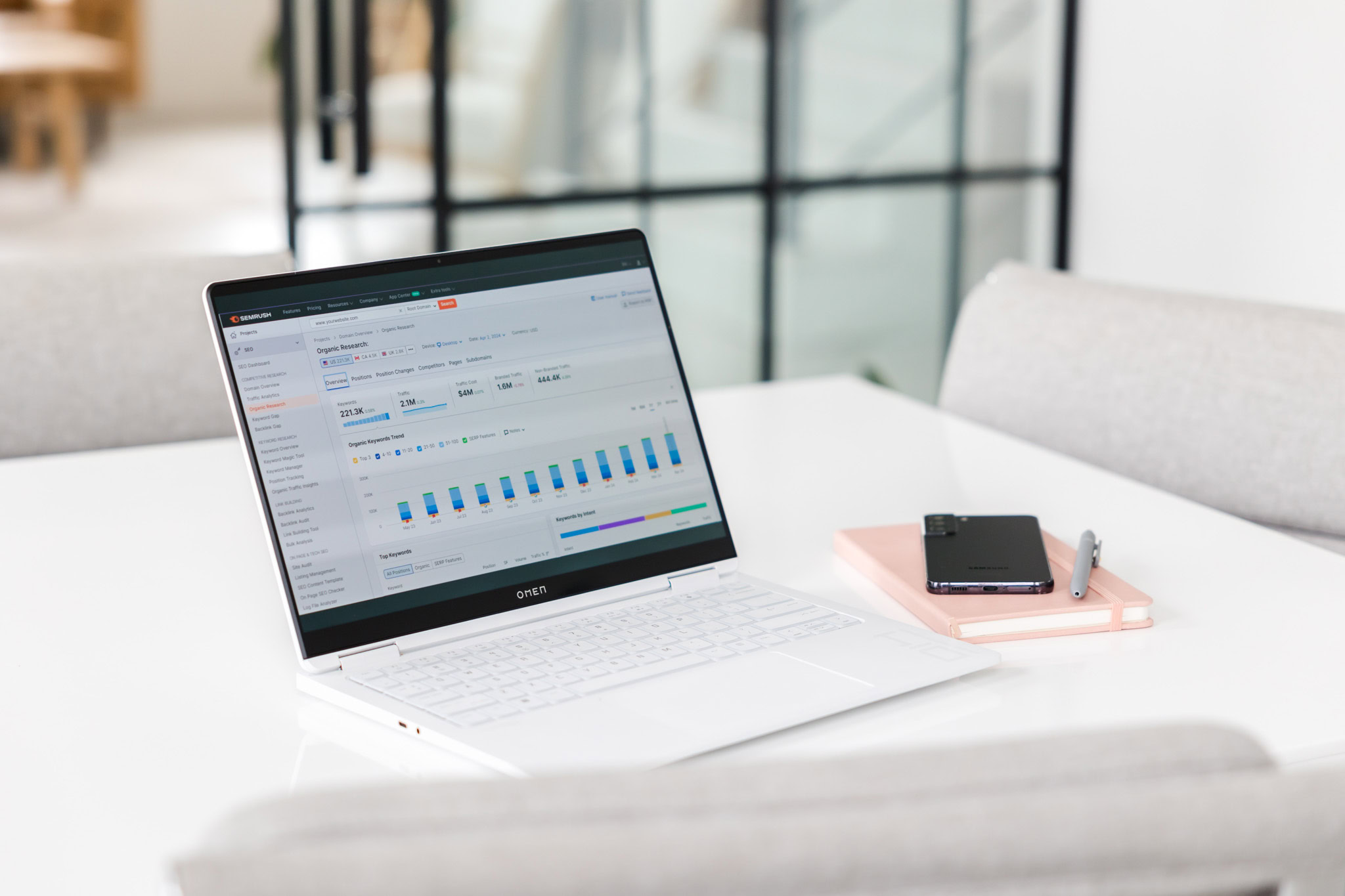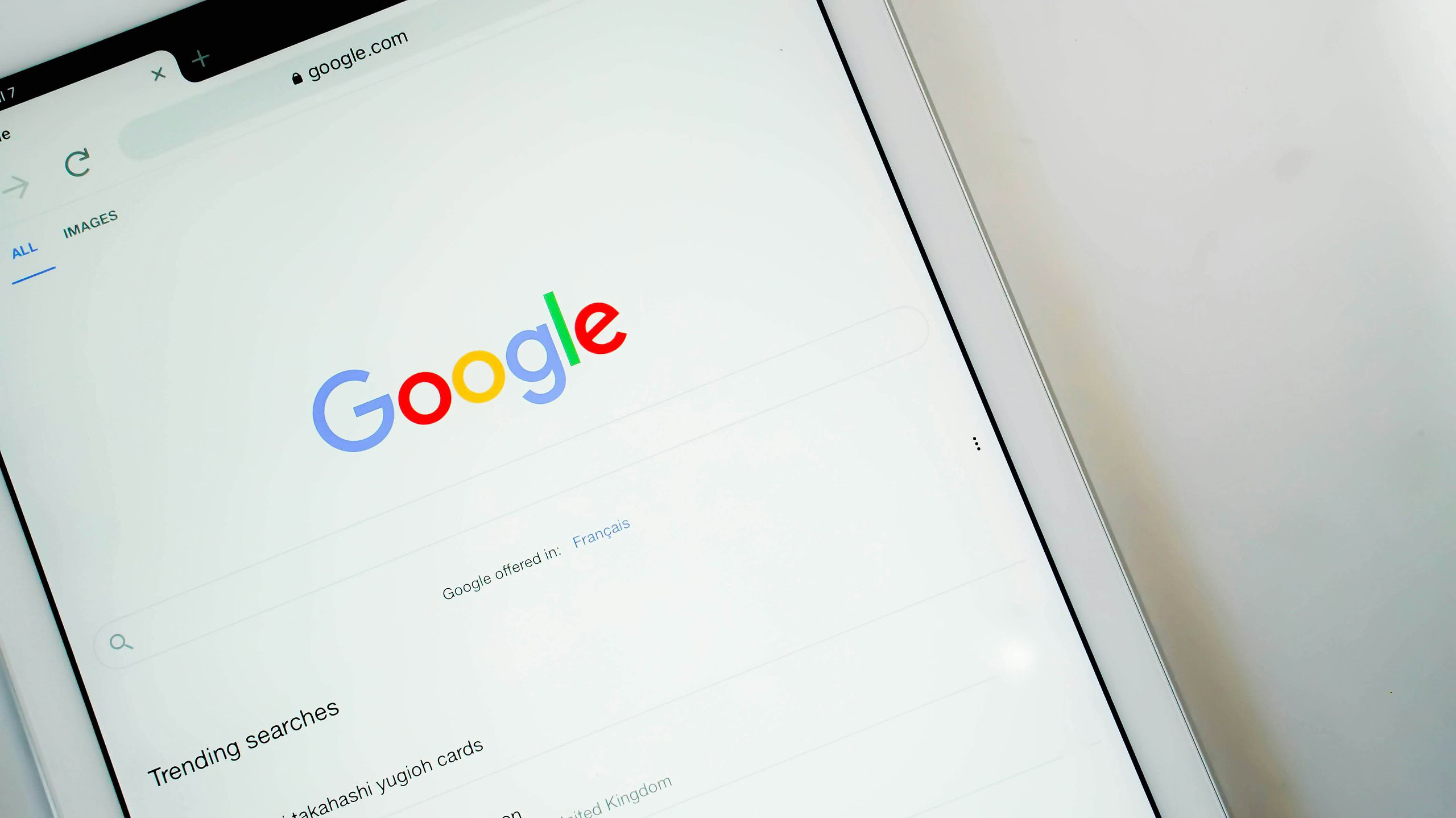Let’s cut to the chase: you work hard to climb Google’s search results, but lately, it feels like you’re shouting into the void. Your content shows up, but clicks? Not so much. Welcome to the wild new world of zero-click search—where rising impressions and falling clicks are the new normal.
Understanding the Rise of Zero-Click Searches
Defining Zero-Click Searches
So, what is zero-click search? It’s when users find exactly what they need – directions, definitions, recipes, business hours – right on the search engine results page (SERP). No click required. Google and other engines pull answers straight into features like featured snippets, direct answer boxes, knowledge panels, AI overviews, local packs, and those ever-expanding People Also Ask sections.
What’s fueling this? Google’s obsession with user satisfaction and speed – leading to their snackable answers for searchers on the go.
Why Zero-Click Searches Matter in Today’s SEO Landscape
Zero-click searches have completely flipped the SEO playbook. The old tricks just don’t cut it anymore. From my experience as the technical SEO lead at Trebletree, succeeding today means crafting high-quality, laser-focused content, mastering structured data, and optimizing for those eye-catching rich results. Nail these, and you won’t just boost click-through rates – you’ll drive meaningful, engaged traffic that sticks around.
It’s no longer enough to “just rank” – you need to be visible in the right features, at the right time. Impressions, brand recall, and topical authority are the new north stars. If your brand shows up in a featured snippet or knowledge panel, users start to see you as the expert – even if they don’t visit your site. For marketers, that means rethinking KPIs and focusing on how often you’re seen, not just how often you’re clicked.
The Impact of Zero-Click Searches on SEO
How Zero-Click Results Affect Organic Traffic and Business Strategies
Let’s talk impact. zero-click searches jumped from 26% in 2022 to 60% in 2025. That’s not a trend — that’s a fundamental shift in how users interact with search.
According to BrightEdge (via Danny Goodwin), Google search impressions are up 49% year-over-year, but click-through rates are down 30%. We’ve seen this trend appear across all of our clients. Why? The rise of AI Overviews – which have taken the SERP by storm since the start of 2025. Here’s the kicker: 80% of searches with AI Overviews end without a click. Google’s serving up answers so complete that users never need to leave.
So what’s the play? Stop chasing clicks and start owning SERP real estate. Featured snippets, AI Overviews, local packs—these aren’t traffic killers, they’re brand builders. At Trebletree, we’ve watched clients appear in zero-click features and see the payoff show up later as direct traffic and branded searches. Your attribution model might miss it, but the impact is real.
Industries Most Affected by Zero-Click Trends
Industries built on high-volume, information-heavy content — healthcare, education, finance, and publishing — are seeing the biggest shifts.
According to a May 2025 BrightEdge Report we’ve seen these impacts to AI Overviews:
- Healthcare and education queries now show AI Overviews in nearly 90% of cases
- B2B tech went from 36% to 70% AI Overview coverage
- Insurance jumped from 17% to 63%
- Entertainment saw a 2% → 37% increase
Meanwhile, ecommerce is mostly spared — AI Overviews for ecommerce queries actually declined from 29% to 4%.
The types of queries are evolving too:
- 7x increase in queries with 8+ words
- 48% rise in searches with technical terminology
- A huge spike in AI citations from lower-ranking pages — even results in positions 21–100+ are now getting pulled into Overviews
The Local Pack – The Last Protected SERP Real Estate
In a search landscape dominated by zero-click results and AI summaries, local businesses still have one major advantage: intent.
When someone searches for a service “near me,” they’re not looking for a paragraph-long AI explanation — they’re trying to take action. That’s where the Local Pack and Google Business Profile still deliver real results.
Local features may technically fall under the “zero-click” umbrella, but they drive phone calls, bookings, map taps, and in-store visits. The click to your website might be skipped, but the customer interaction still happens.
And unlike AI Overviews, Google still rewards businesses for putting in the work: uploading photos, collecting reviews, updating hours, and posting consistently. In local search, accuracy and presence still pay off.
For now, the Local Pack remains one of the last pieces of clickable, actionable real estate on the SERP — and it’s one that businesses can still control.
Myths vs. Realities: What Zero-Click SEO Actually Means
Let’s clear up a few misconceptions:
- Myth: Zero-click searches are killing SEO.
Reality: SEO isn’t dead—it’s just evolving. It’s no longer just about clicks, but about influence, visibility, and downstream engagement. - Myth: Being in a zero-click result hurts your brand.
Reality: Showing up in snippets, panels, or Overviews often boosts brand authority, recall, and conversions—just not always in ways Google Analytics makes obvious. - Myth: If it doesn’t bring a session, it didn’t work.
Reality: Calls, direct visits, and brand searches can all be sparked by a zero-click impression. If you’re not measuring these, you’re missing the bigger picture.
The bottom line: SEO success today includes impressions, visibility, brand engagement, and real-world conversions—not just the click. Zero-click search is not the end of organic strategy. It’s a challenge to measure better, optimize smarter, and meet users where they find answers fastest.
Types of Zero-Click Search Results
Zero-click search isn’t one thing—it’s a whole ecosystem of SERP features designed to give users answers without requiring a click. Here’s a breakdown of the most common (and powerful) types:
✅ AI Overviews
AI Overviews pull insights from multiple sources to deliver rich, contextual answers directly in the search results. These are most common on informational queries, especially in categories like health, science, education, and finance.
Over the past year, we’ve seen AI Overviews increasingly replace featured snippets, People Also Ask boxes, and even some Knowledge Panels. And here’s the kicker: 80% of searches with AI Overviews end without a click. The summaries are so complete that users often don’t feel the need to click through.
Why it matters: Being featured in an AI Overview can boost your brand’s visibility and authority—and in some cases, outperform a traditional snippet in terms of long-term trust or recall. To increase your chances, focus on strong E-E-A-T signals, use structured data, and build deep topical relevance across your content.
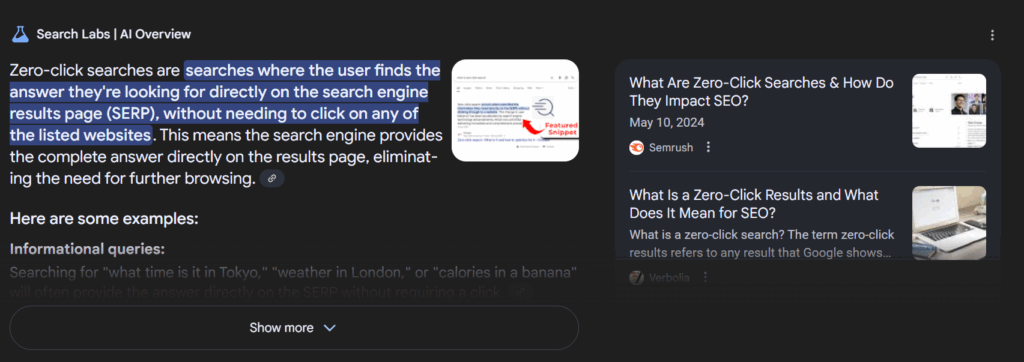
✅ Knowledge Panels
Displayed on the right side of desktop search, knowledge panels summarize info about businesses, people, places, or organizations. Google pulls from trusted sources like Wikipedia, Google Business Profiles, and structured data.
Knowledge Panels are slowly getting replaced with AI Overviews. However, when they do display note how they take over the majority of the SERP before you even get to any clickable results.
Why it matters: You can’t always control it—but accurate schema, consistent NAP info, Wikidata, and Google Business Profile optimization all increase your odds of appearing here.
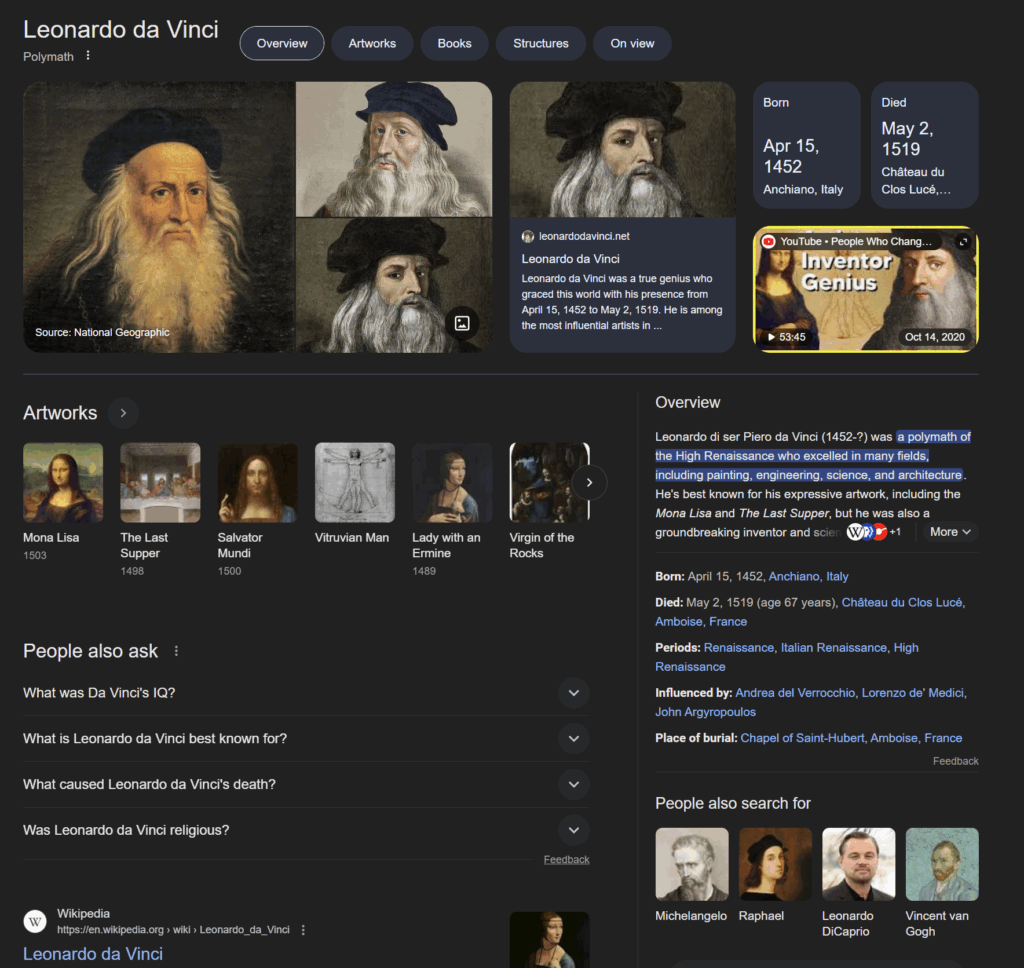
✅ Local Packs
For queries with local intent (“pizza near me”), the local pack displays a map, three top results, business hours, ratings, and a link to directions—all without a single website visit.
Why it matters: This is one of the few remaining SERP features where action still happens—calls, visits, and direction requests. A well-managed Google Business Profile, local schema, and consistent citations are your ticket in.

✅ People Also Ask (PAA)
These expandable accordion-style boxes feature follow-up questions and quick answers pulled from websites. Each expansion reveals more related questions, keeping users in a loop.
Why it matters: Getting featured here builds brand presence across long-tail and related searches. Structuring content with questions and clean answers (hello, FAQ schema) helps improve your chances.
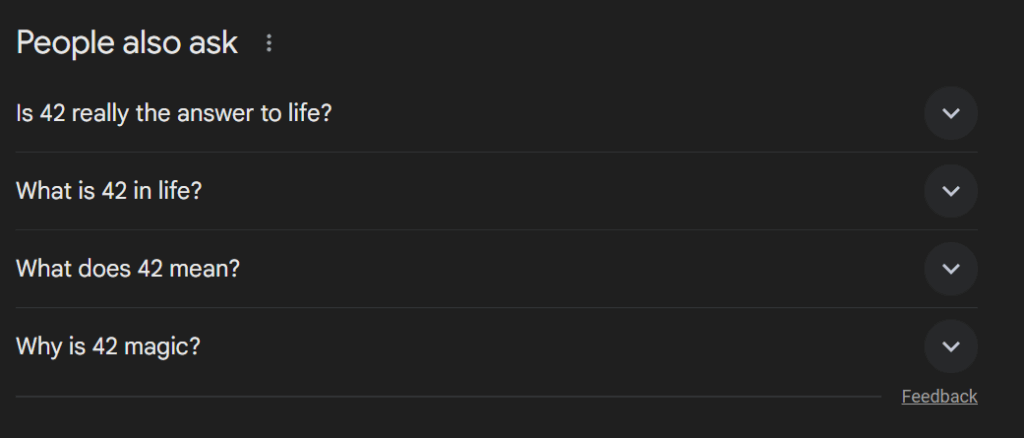
Adapting Your SEO Strategy for a Zero-Click World
Targeting and Winning Featured Snippets
To win those prized snippets, go after question-based keywords (“what is zero-click search,” “how does zero-click seo work”) and provide clear, direct answers. Use structured headings, bullet points, and lists—Google loves content it can easily extract. At Trebletree, we’re big fans of reworking existing high-performing content for snippet potential, since it’s often faster than starting from scratch.
Target the “paragraph” snippets by providing 40-60 word answers immediately after your H2 headings. For list snippets, use numbered or bulleted lists with 3-8 items. Table snippets work great for comparisons—think pricing, features, or step-by-step processes laid out clearly.
Implement Structured Data (Schema Markup) Strategically
Schema markup is one of the most effective tools for earning visibility in zero-click search results. To understand its role, it helps to clarify the distinction between structured data and schema markup:
- Structured data is a standardized format (usually in JSON-LD) that helps search engines better interpret and classify your page content.
- Schema markup refers to the specific vocabulary from Schema.org used to implement that structured data in your HTML.
In practice, schema helps Google extract key information—like step-by-step guides, business hours, FAQs, services, and product data—and surface it directly in search results as a featured snippet, knowledge panel, or other rich result. These are often the sources of zero-click visibility.
High-Impact Schema Types for Zero-Click Optimization:
1. FAQ Schema
Perfect for earning expandable Q&A content directly under your result.

2. HowTo Schema
Ideal for tutorials or step-by-step instructions that can be displayed in SERPs.

3. LocalBusiness Schema
Essential for local businesses looking to stand out in the map pack or knowledge panel. This schema communicates location, hours, contact info, and services.

4. Service Schema (and Product Schema)
If you’re offering services or selling individual products, schema can help display rich details like price, availability, and descriptions—especially in conjunction with your Google Business Profile or Knowledge Panel.
- Use Service schema for offerings like consultations, training programs, repairs, or audits.
- Use Product schema for tangible items or digital products with clear pricing and inventory.
Here’s an example of Service schema with embedded offer details (similar to how Product schema would be structured):

If you’re in ecommerce, swapping @type: “Service” with @type: “Product” and adding fields like brand, sku, and aggregateRating would make this markup eligible for product-rich results like carousels and price comparisons.
Don’t Stop at the Obvious: Use All Applicable Schema Types
While these rich-result types are the most visible, don’t stop there. A complete schema strategy should also include foundational markup that helps search engines and large language models understand who you are, what your content is about, and why you’re a trusted source. These include:
- Organization / LocalBusiness schema – Reinforces brand identity, including your logo, contact info, and social links.
- WebPage schema – Helps define the role of each page (e.g., FAQPage, AboutPage, CollectionPage), improving clarity and crawl efficiency.
- Article / BlogPosting schema – Essential for content hubs and editorial SEO. Helps with author recognition, date clarity, and headline accuracy in both SERPs and AI summaries.
- Person schema – Useful for author bios, especially when building EEAT signals through demonstrated expertise.
- BreadcrumbList schema – Supports enhanced site structure display and improves internal navigation context.
These types may not trigger flashy rich results, but they are essential for establishing context and credibility—both for search engines and for the AI systems now shaping user journeys. If you’re thinking about how to improve LLM visibility (large language model visibility), comprehensive schema markup is one of the most important foundations you can control.
Use all applicable schema types across your site—not just the ones tied to featured snippets. Schema helps organize your content for every kind of system interpreting the web today—and tomorrow.
Focusing on High-Value Visual Content and E-E-A-T
Google’s SERP features increasingly favor rich, visual experiences—think image carousels, video packs, thumbnail-enhanced results, and even AI-generated snapshots that pull in branded visuals. To stand out in a zero-click environment, high-quality visual content is essential—but it’s not just about looking good. It’s about building trust and demonstrating authority at a glance.
That’s where E-E-A-T comes in: Experience, Expertise, Authoritativeness, and Trustworthiness. These are the core signals Google uses to evaluate content quality, especially in YMYL (Your Money or Your Life) topics—but they’re relevant for every industry looking to earn real estate in rich results, AI Overviews, and zero-click SERPs.
Here’s how to integrate strong EEAT principles into your visual and on-page content:
- Experience: Show real-world application. Use original photos, behind-the-scenes videos, or hands-on walkthroughs—especially from professionals who’ve actually done the work. Stock photos are a dime a dozen; what matters is authenticity. Capture real locations, products in action, or your team solving real problems.
- Expertise: Back up your claims with credentials and data. Visually highlight expert contributors (include headshots, bios, or video clips), cite reputable sources, and use data visualizations that make complex insights easier to digest. If you’re sharing instructions or advice, make sure it’s authored or reviewed by someone with actual qualifications or proven experience in the topic.
- Authoritativeness: Establish your brand’s credibility in the space. This could be through logos of publications you’ve been featured in, awards, partnerships, or long-standing client relationships. On the visual side, that means clean, branded design; consistent voice and style across graphics; and polished video content that reflects a professional standard.
- Trustworthiness: Reinforce transparency and accuracy. Use visuals to highlight reviews, testimonials, case studies, and before-and-after results. Add trust seals, client quotes, or metrics that reinforce performance and reliability. Visually include your contact info, business address, and policies where appropriate—especially on product or service pages.
Optimizing for Local SEO: The Last Protected Space
As zero-click search continues to expand, local SEO remains one of the few spaces where users still take action—calling, getting directions, or visiting in person. For local businesses, this is your most defensible territory in search, and it’s essential to optimize it holistically—not just through your Google Business Profile (GBP), but across your website and the local web.
Let’s start with the foundation:
Google Business Profile Optimization Checklist
Your GBP is often the first (and only) touchpoint users see. Keeping it updated and optimized can significantly impact how often you appear in the map pack and how users engage.
- ✅ Post weekly updates with local keywords and community events
- ✅ Respond to all reviews—positive or negative—within 24–48 hours
- ✅ Add high-quality, authentic photos of your location, staff, services, and products
- ✅ Keep your hours accurate and update them for holidays or seasonal changes
- ✅ Use Google Posts to promote offers, events, and updates
- ✅ Encourage customer reviews through email and SMS follow-ups
- ✅ Add detailed business descriptions that include your services and target geography
But that’s just the start.
Local SEO Goes Beyond GBP
To build long-term visibility in your area and strengthen zero-click opportunities, you also need to focus on website and content-level local signals:
- Location Pages with Unique Content
Create individual pages for each location or service area that go beyond just listing hours and contact info. Include locally relevant content—nearby landmarks, community involvement, testimonials from that location, and custom visuals. This boosts both rankings and relevance in local queries. - Local Schema Markup
Implement LocalBusiness and Organization schema across your site. If you offer different services by location, include Service schema as well. This structured data helps Google reinforce your physical presence and improves your eligibility for rich local results and knowledge panels. - Citations and NAP Consistency
Ensure your Name, Address, and Phone number (NAP) are consistent across your website, local directories, and review platforms. Use tools like Yext, Whitespark, or BrightLocal to manage your citations and spot inconsistencies that can hurt your rankings. - Localized Content & Internal Links
Publish blog posts or landing pages about local events, FAQs by region, or partnerships with nearby businesses. Internally link to your location pages using natural local anchor text (e.g., “our Dallas martial arts studio”) to reinforce local intent. - User Behavior & GBP Engagement Metrics
Remember: Google uses signals like driving directions, calls, photo views, and review interactions to influence local rankings. A well-optimized GBP combined with a strong website can drive those micro-conversions—even if users never click through.
Local SEO is more than just checking a few boxes—it’s about showing up as the most trusted option in your community. While zero-click search may reduce traffic to content-heavy national pages, it actually highlights the importance of local visibility. Because when someone searches “near me,” they’re not just browsing—they’re ready to act.
Diversifying Traffic Sources Beyond Google
Zero-click search proves one thing: you can’t rely on Google alone anymore. With 60% of searches ending without clicks, smart brands are adopting what experts call “Search Everywhere Optimization”—building visibility across every platform where their audience seeks answers.
The diversification playbook:
- Social platforms: LinkedIn, Twitter, TikTok, Instagram
- Video channels: YouTube, podcast appearances, webinars
- Community spaces: Reddit, Quora, industry forums
- LLM visibility: Optimizing for ChatGPT, Claude, Perplexity citations
- Email and owned media: Newsletters, direct relationships
- Traditional media: PR, guest posting, thought leadership
This isn’t about abandoning SEO—it’s about being everywhere your audience looks for answers. When Google serves up zero-click results, your brand needs touchpoints beyond the SERP. Repurpose your best content across channels, build genuine relationships, and create multiple paths back to your brand.
The goal? When Google doesn’t send the click, something else will.
🧠 Coming soon: Our top strategies to optimize your content for LLM visibility →
Measuring Success: Rising Impressions and Falling Clicks
Key Performance Indicators for Zero-Click Environments
In a zero-click world, visibility often matters more than clicks. Traditional metrics like CTR are declining, so it’s time to focus on performance indicators that reflect influence, presence, and engagement beyond the visit.
What to Track:
- Impression growth across branded and non-branded terms
- Visibility in SERP features including featured snippets, People Also Ask, knowledge panels, AI Overviews, image packs, and video carousels
- Local pack presence and GBP engagement (calls, direction requests, reviews)
- Branded search volume and digital brand mentions
- Direct traffic growth and increases in homepage or branded landing page sessions
We use Google Search Console for baseline data and SEO Stack to analyze long-tail queries, impression spikes, and shifts in search behavior, especially when clicks stay flat. Tools like Semrush and SERanking help us track visibility across zero-click features, while Google Business Profile metrics are essential for local engagement signals.
Measuring Zero-Click Impact
Success in a zero-click landscape means recognizing that SEO drives value beyond immediate sessions. Increased visibility can lift direct traffic, branded searches, and even conversions without showing up as a click in your GSC reports.
In many cases, we see revenue or lead growth even when clicks are flat – because users see your brand in a featured snippet or AI Overview, remember it, and come back later through a different path. Whether it’s direct traffic, offline conversions, or assisted conversions via paid channels, zero-click visibility plays a critical role in the journey.
As impressions rise and CTR declines, it’s clear that visibility is the new battleground for SEO. If users see your brand, trust your expertise, and take action – even if it’s not right away – that’s a win.
Track accordingly. Win differently.
Anticipating the Next SEO Trends: How Zero-Click Will Shape Future Digital Strategies
Zero-click search isn’t going away. If anything, it’s evolving – expect more AI-driven, conversational, and interactive SERP features. The brands that thrive will be the ones who adapt quickly: prioritizing user intent, building structured and visual content, and investing in omnichannel presence.
Zero-Click Success Checklist:
✅ Create question-focused content targeting featured snippets and add FAQ schema
✅ Audit and optimize your Google Business Profile weekly (perfect for local)
✅ Set up tracking for impressions and SERP feature appearances
✅ Diversify content across 3+ platforms
✅ Monitor branded search volume and direct traffic trends
✅ Add high-quality visual content to all key landing pages (emphasizes quality)
✅ Test and validate all structured data implementations
✅ Build content clusters around core topic expertise
Keep your content fresh, watch the trends, and experiment with new formats. As Rand Fishkin and other thought leaders emphasize, “SEO goes where people go as they search and find answers that apply to the world around them”. That means your brand needs to show up in more than just the traditional ‘Ten Blue Links’. Whether it’s a featured snippet, a carousel, a YouTube result, or a GBP profile – your visibility now lives across an entire SERP experience.
Zero-click isn’t the end of SEO. It’s a shift in the shape of search success. Winning means being present, relevant, and trusted—even when there’s no click to prove it. The real test is whether users remember you, return to you, and choose you—whether that journey starts on Google or not.
Get visible. Stay credible. Be everywhere your audience is already looking.
Curious how your brand can stand out in a zero-click landscape? Check out our organic marketing insights and digital strategy tips for inspiration. Let’s grab a coffee and talk strategy – no cookie-cutter answers, just smart, custom solutions from the team at Trebletree.

